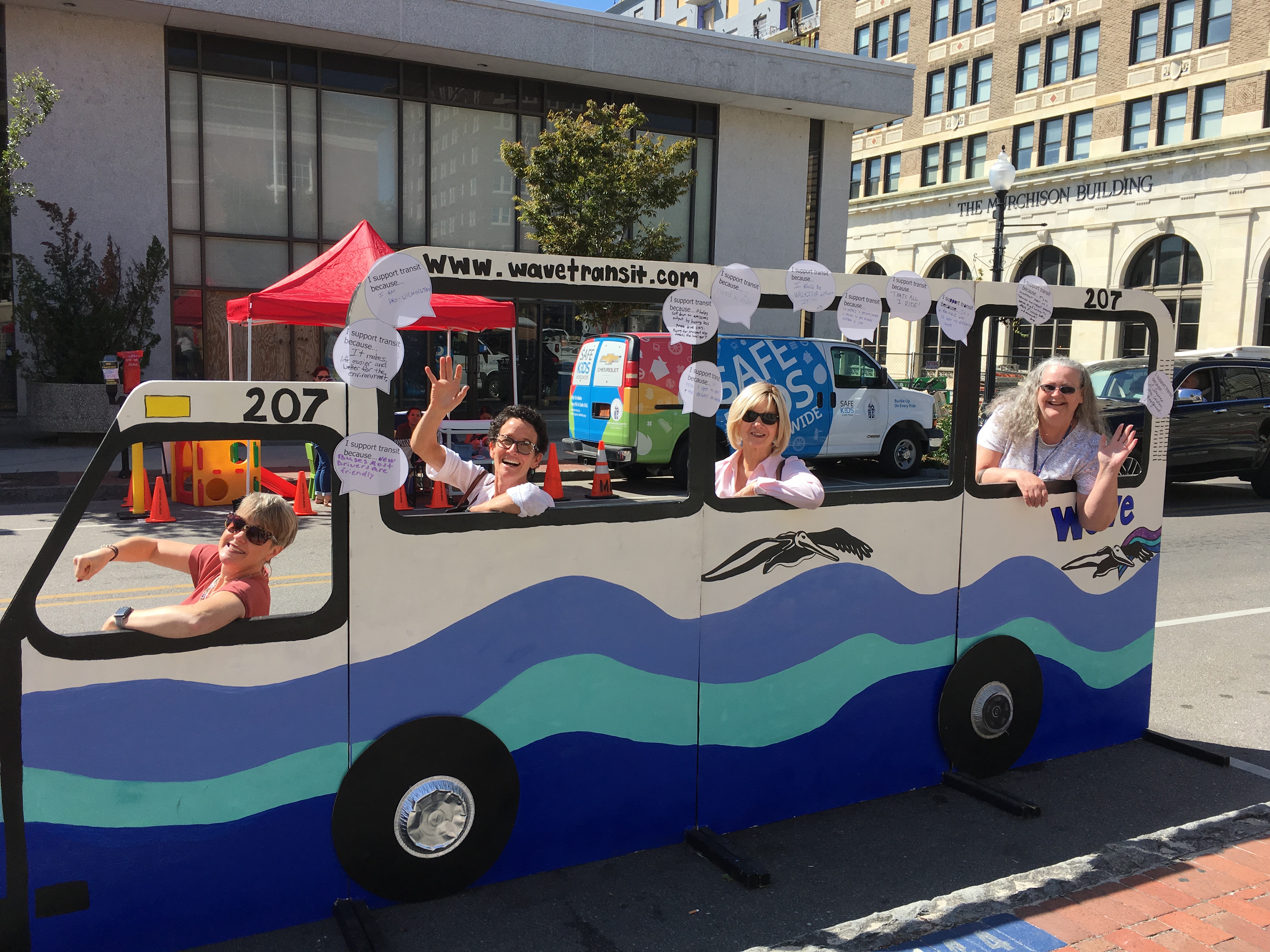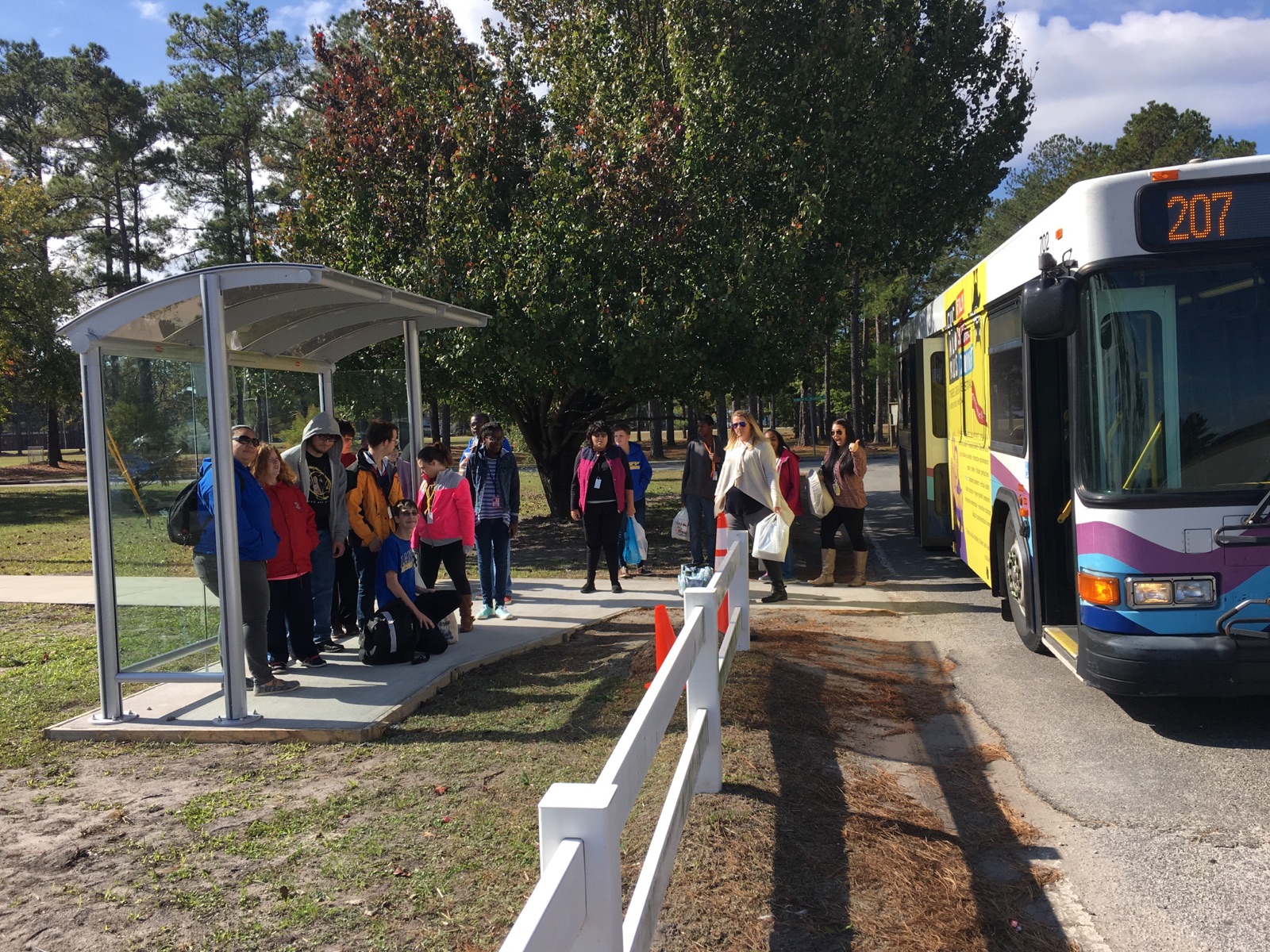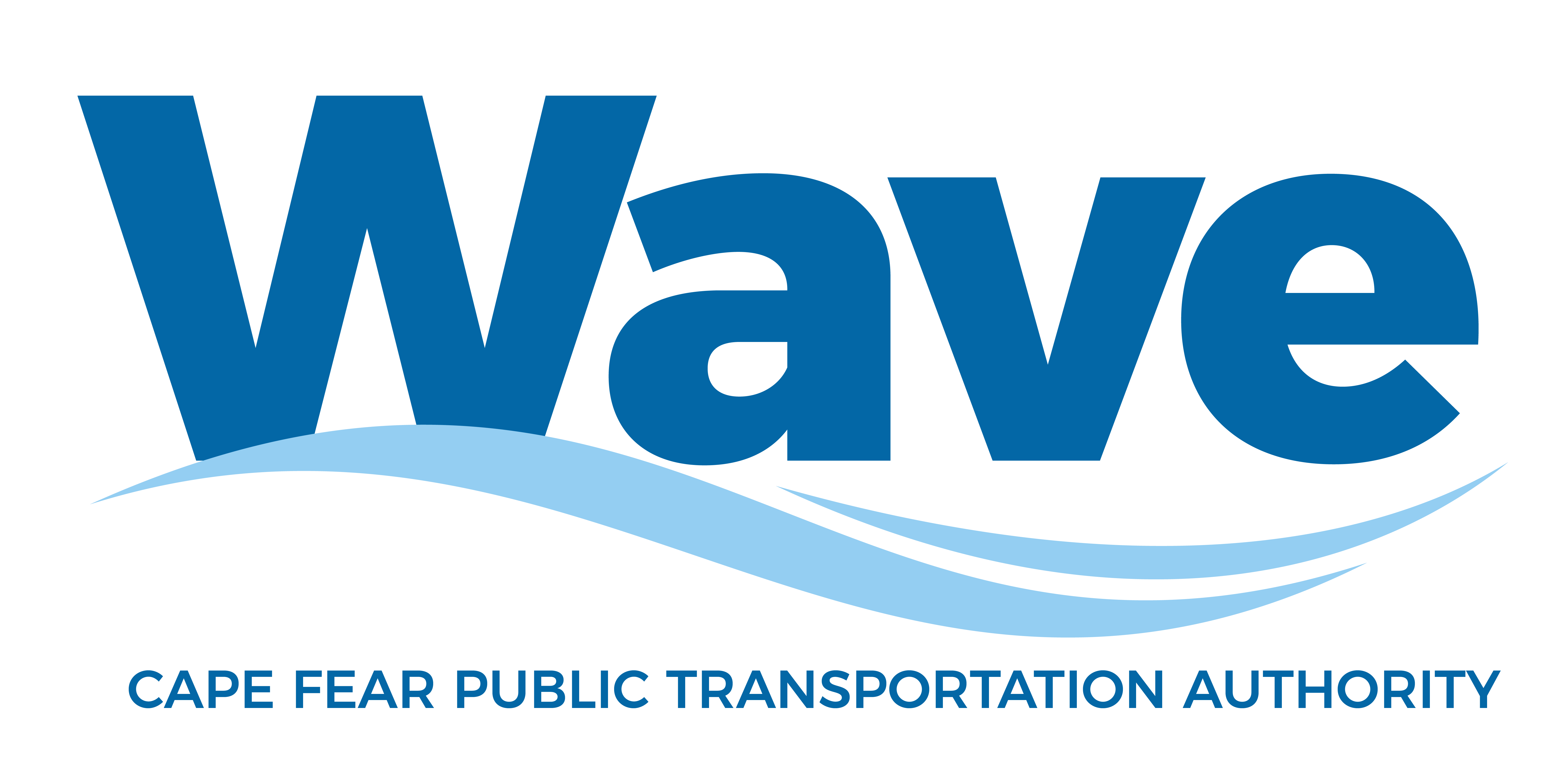The Benefits of Wave Transit to our Community
As the public transportation provider for the Cape Fear region, Wave Transit has a positive impact on residents in the City of Wilmington, New Hanover County, Carolina Beach, and Northern Brunswick County. And, through the WavePool Program (an employment-based vanpool program), the advantages of public transportation are even felt as far as Elizabethtown, NC. Wave Transit provides economic, safety, and environmental benefits to all residents of the Cape Fear region, even those that do not ride.
Why Public Transit Matters
The transportation services provided by Wave Transit affect the local job market and economy, community health and the environment, and provide access to opportunities that allow our neighbors to maintain or increase their quality of life. Some impacts, like the benefit to the local economy, are easily described with a dollar amount, but others are more difficult to quantify. The cost savings of transitioning our fleet of vehicles to an alternative fuel source can easily be quantified with a dollar amount. However, for a mother, who because of Wave Transit, is able to take her child to the library for story time or attend a parents’ meeting at school, the benefits are priceless.

Jobs and Local Economy
Wave Transit is part of the underlying economic engine in the local community, employing approximately 130 workers, with approximately $4 million in annual salaries. We directly purchase an additional $1.5 million from local businesses in the form of goods and services. Wave Transit has a positive impact on our local economy, putting $5.5 million back into the hands of individuals and business in our community.
When asked, the majority of Wave Transit customers commuting by bus are traveling to work or to school. Additionally, Wave Transit provides safe, accessible, and low-cost transportation to people with disabilities through our Dial-A-Ride Transportation (DART) accessible van program. Our community rides Wave to connect to employment, education, and other opportunities.
Did you know…
Wave Transit impacts the local economy, providing 130 jobs and putting $5.5 million back into the community every year. In fiscal year 2019, July 1, 2018 thru June 30, 2019, Wave Transit provided over 1.3 million fixed route bus rides and over 59,000 accessible van trips to residents travelling to and from retail stores, medical appointments, employment and school.
Community Safety
Safety is engrained in our organizational culture and remains our number one priority. With over one million miles travelled per year on our fixed route bus and Seahawk Shuttle services, we are proud to report only five major accidents during this time. This accident rate is a reflection of a robust safety program which encompasses all operators and safety sensitive employees. Public transportation reduces the number of single occupancy vehicles, thus reducing traffic congestion and the opportunity for roadway collisions.
Our commitment to delivering safe services to the community is not only evident through internal policies, procedures, programs and compliance with Federal Transportation Administration (FTA) regulations, it is shown through upgraded passenger amenities offered to our customers. Our customers deserve accommodations, removed from the elements, that provide a safe location when transferring routes and/or waiting for a bus. Prior to the completion of Forden Station in 2011, Wave Transit’s main transfer center consisted of five covered shelters located on Columb Dr. behind Target. We knew we could offer our customers and the community something better.
In January 2020, Wave Transit permanently relocated its Downtown transfer center, an on-street, open air transfer station located on 2nd St. and Princess St., to an off-street facility located at 520 North 3rd St. A once vacant, dilapidated building located along the gateway to the City of Wilmington has now been renovated to serve at Wave Transit’s Downtown Transfer Station, Padgett Station. The new transfer facility offers customers improved safety, accessibility, convince, and comfort.
Did you know…
Last year, over 97,000 transfers were performed on our fixed route system.
Did you know…
The economic development from the construction of three facilities over the past eight years totals over $24 million. All three facilities were funded, in full, at over 95% from non-local sources. No debt was incurred from these projects as Wave Transit is prohibited from incurring debt. We remain debt free.
Funds used to construct these facilities can only be used for one time projects such as the construction of a facility or the purchase of a vehicle and cannot be used to support operations/fund a route.

Environmental Stewardship
Since 2010, the Breathe Easy… initiative has demonstrated Wave Transit’s commitment and responsibility to reduce vehicle emissions, minimize our carbon footprint, and reduce our dependence on foreign oil. The initiative includes low emissions vehicles fueled by Compressed Natural Gas (CNG) and hybrid electric, the WavePool Program, an employment based vanpooling program, and sustainably built facilities.
The Authority’s transition from diesel powered to CNG powered has had both a significant environmental and economic benefits. Since 2015, a total of 22 diesel powered vehicles have been replaced with CNG. The exhaust emissions from the from the CNG Cummins Westport L9N engine found in our 35ft buses is 90% lower than the current EPA nitrous oxide limit of 0.2 g/bhp-hr. The economic benefit that accompanies the environmental impact of this conversion is an total cost savings of $532,315; an average annual savings of over $100,000.
Did you know…
Wave Transit helps the environment by reducing vehicle emissions, providing a low emissions alternative to driving, and facilitating compact development. A typical commute of twenty miles round trip by a single commuter is equal to 1/40th passengers per mile. Wave Transit currently transports over one passenger per mile.
Did you know…
Forden Station, Wave Transit’s main transfer facility constructed in 2011, and our Maintenance and Operations Facility constructed in 2016, were built to LEED standards. Each facility contains 32 geothermal wells which naturally heat and cool the facility. Forden Station contains a vegetative roof which acts as a natural insulator which controls the interior climate of the building.
In the News (FAQs)
Click below for answers to many of the questions community members may have regarding Wave Transit.
I do not utilize public transportation services. Why should I support Wave Transit?
You may not ride the bus but you probably eat at restaurants, shop at stores, and need services such as landscaping, childcare, cleaning, construction (etc.). Wave Transit customers are part of our local workforce, performing jobs that are the backbone of businesses in our community. When you support transit you are supporting our local economy.
Transit service is infrastructure, like a park. You may not visit the park every day, but when you do the park is available to you. You may not need to ride the bus or travel by accessible van today, but all of us who currently drive will one day need alternate transportation. When you support transit you make an investment in your and your community’s future.
Who owns Wave Transit?
We do! Created in 2004 by a joint resolution between the City of Wilmington and New Hanover County, Wave Transit is a publicly funded agency that exists to provide public transportation services to individuals in our region. Wave Transit is the designated recipient of federal funding from the Federal Transportation Administration (FTA) for the New Hanover County and Northern Brunswick County urbanized area (UZA). Wave Transit is required by federal law to provide public transportation services in an equitable manner throughout the urbanized area (UZA).
How is Wave Transit funded?
Wave Transit is a publicly funded agency that receives revenues from federal, state and local sources as well as fares paid by customers. The funding, or subsidy, received by the Federal Transportation Administration (FTA) is roughly $2.4 million and based upon the following formula: bus revenue miles, bus revenue hours, bus passenger miles, population and population density. In 2017, the cost per vehicle revenue hour was $76.10, well below the national average of $133.18.
As a recipient of public funds, Wave Transit operates under a complex set of federal and state regulations ranging from Civil Rights to employment laws to the federal office of management and budget. Wave Transit is not responsible for funding policies made a the federal, state and local levels.
The majority of Wave Transit’s funding comes from federal subsidies, followed by state grant funds and local funding provided by the City of Wilmington, New Hanover County, the Brunswick Consortium, the Town of Carolina Beach, the University of North Carolina Wilmington and passenger fares. As noted, we are not a private business and rely on public funds to support one-time projects and overall operations.
Can Wave Transit sustain itself on fares collected from passengers?
No public transit agency in the United Sates, Wave Transit included, can operate exclusively on fares paid by customers. Additionally, no public transit system in the United States, Wave Transit included, operates without a federal subsidy from the Federal Transportation Administration (FTA). Fares recouped from customers make up a fraction, roughly 12%, of revenues needed to support operations.
How does the community benefit from UNCW Seahawk Shuttle services?
Our region has witnessed unprecedented growth over the past five years, and the same is true for UNCW. With student enrollment on the rise, the development of both off campus and on campus student housing has kept, or attempted to, keep pace. The increase in housing units along the Randall Pkwy. and the Kerr Ave. corridors is a testament to the accommodations needed to support the growth in student enrollment. Growth is impactful to resources and infrastructure currently strained. Public transportation offered through the Seahawk Shuttle program mitigates the strain on infrastructure and helps to preserve our roadways.
Last academic school year, August 2018 thru May 2019, a total of 327,260 trips to and from campus were performed utilizing the Seahawk Shuttle service. The result is a decrease of 327,260 opportunities for a single occupancy vehicle to be used to perform this trip to and from UNCW campus. With an average of 1,600 weekday trips removed from roadways, including College Rd. and Randall Pkwy., surrounding the University. The positive impact on traffic congestion through use of public transportation is significant.
Fact: UNCW provides 100% of the local funding needed for the operation of the Seahawk Shuttle service. The cost of transportation services are recouped by the University through fees charged to students. Seahawk Shuttle services are available to the public and not exclusive to UNCW students.



